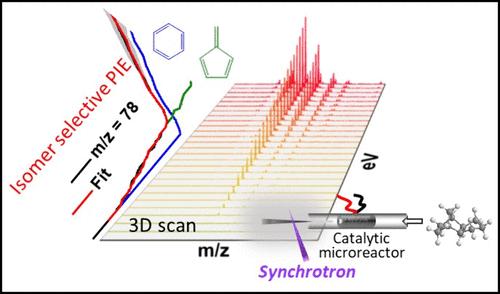A Synchrotron-Based Vacuum Ultraviolet Photoionization Mass Spectrometer-Coupled Microreactor To Probe Thermocatalysis
IF 6.7
1区 化学
Q1 CHEMISTRY, ANALYTICAL
引用次数: 0
Abstract
Vacuum ultraviolet photoionization (VUV-PI) mass spectrometry offers an isomer-selective and universal ionization with minimal fragmentation detection of organics in complex chemical systems such as pyrolysis and combustion. Here, we report a state-of-the-art experimental setup of a universal catalytic microreactor combined with a molecular beam to investigate the thermocatalytic oxidation of a heterogeneous system relevant for probing reactions at gas–solid interfaces. In strong contrast to traditional off-line analytical methods, this technique is capable of identifying and quantifying short-lived species (radicals) as well as stable products to decipher initial reaction steps via the detection of nascent products. The thermocatalytic oxidative degradation of exo-tetrahydrodicyclopentadiene (JP-10), a high energy-density hydrocarbon fuel, over solid titanium–aluminum–boron reactive mixed metal nanopowder (Ti-Al-B RMNP) is exploited to showcase potential applications. Overall, some 59 nascent gas-phase products are identified via photoionization efficiency (PIE) curves, including oxygenated species and hydrocarbons comprising closed-shell molecules and radicals. The critical temperature for complete oxidative decomposition of JP-10 was lowered by 450 K from 1400 K to 950 K, indicating an efficient thermocatalytic action of Ti-Al-B nanoparticles on JP-10. The enabling of a universal chemical microreactor along with VUV-PI mass spectrometry broadens the applicability of this technique to hydrocarbon fuel oxidation and pyrolysis characterization. This isomer-selective sensitive probing along with the detection of radical transients makes the aforementioned technique superior to other conventional analytical techniques such as microflow tube and pyrolysis-gas chromatography coupled with mass spectrometry for investigating similar pyrolysis reactions and comprehensive quantification.

基于同步加速器的真空紫外光电离质谱耦合微反应器探测热催化
真空紫外光电离(VUV-PI)质谱法在热解和燃烧等复杂化学系统中对有机物进行最小碎片检测,提供了异构体选择性和普遍电离。在这里,我们报告了一个最先进的通用催化微反应器与分子束相结合的实验装置,以研究与探测气固界面反应相关的非均相系统的热催化氧化。与传统的离线分析方法相比,该技术能够识别和量化短寿命物种(自由基)以及稳定产物,通过检测新生产物来破译初始反应步骤。利用钛-铝-硼反应性混合金属纳米粉(Ti-Al-B RMNP)热催化氧化降解高能量密度烃类燃料外四氢二环戊二烯(JP-10),展示了其潜在的应用前景。总的来说,通过光电离效率(PIE)曲线鉴定了59种新生气相产物,包括含氧物质和含闭壳分子和自由基的碳氢化合物。结果表明,Ti-Al-B纳米颗粒对JP-10具有有效的热催化作用,其完全氧化分解的临界温度从1400 K降低到950 K,降低了450 K。通用化学微反应器的启用以及VUV-PI质谱技术扩大了该技术在碳氢化合物燃料氧化和热解表征中的适用性。这种同分异构体选择性敏感探测以及自由基瞬态检测使上述技术优于其他传统分析技术,如微流管和热解-气相色谱-质谱联用,用于研究类似的热解反应和全面定量。
本文章由计算机程序翻译,如有差异,请以英文原文为准。
求助全文
约1分钟内获得全文
求助全文
来源期刊

Analytical Chemistry
化学-分析化学
CiteScore
12.10
自引率
12.20%
发文量
1949
审稿时长
1.4 months
期刊介绍:
Analytical Chemistry, a peer-reviewed research journal, focuses on disseminating new and original knowledge across all branches of analytical chemistry. Fundamental articles may explore general principles of chemical measurement science and need not directly address existing or potential analytical methodology. They can be entirely theoretical or report experimental results. Contributions may cover various phases of analytical operations, including sampling, bioanalysis, electrochemistry, mass spectrometry, microscale and nanoscale systems, environmental analysis, separations, spectroscopy, chemical reactions and selectivity, instrumentation, imaging, surface analysis, and data processing. Papers discussing known analytical methods should present a significant, original application of the method, a notable improvement, or results on an important analyte.
 求助内容:
求助内容: 应助结果提醒方式:
应助结果提醒方式:


